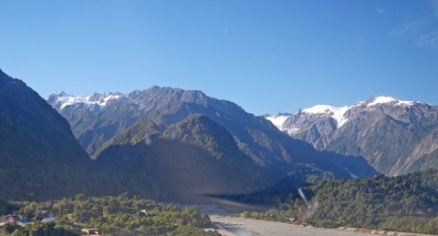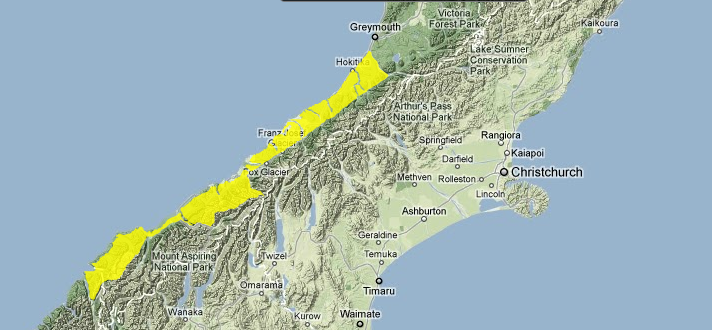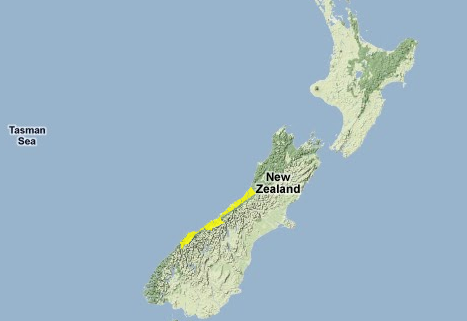Westland temperate forests
Lining the west Tasman Sea coast of New Zealand's South Island, the Westland temperate forests ecoregion is one of the best examples in the world of a dynamic mountain landscape.
Two of the earth's crustal plates, the Pacific and the Indo-Australian, collide here. The Southern Alps rise abruptly from the narrow coastal plain, with the line of plate contact marked by the Alpine Fault.
Large portions of this ecoregion are protected as part of the vast Te Wahipounamu-South West New Zealand World Heritage Area, and this region contains relatively intact natural communities, with complete habitat sequences stretching from estuaries and [[coast]al] cliffs up to alpine habitat.
Location and General Description
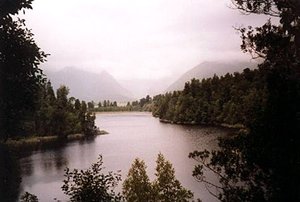 Lake Matheson, New Zealand. (Photograph by Susanne Peck)
Lake Matheson, New Zealand. (Photograph by Susanne Peck) This ecoregion lies on the western side of the Southern Alps and is delineated to the north and south by the Buller and Cascade Rivers, respectively, and by the Tasman Sea to the west. In some places, peaks that reach 3000 metres (m) to 3500 m are only 30 kilometres (km) from the sea.
To the east of the fault the land rises abruptly, with steep forested slopes dissected by deep gorges that drain the extensive snow fields above.
During the Quaternary Ice Age, large sheets of ice covered this entire ecoregion and left behind a legacy of moraine features and steep-sided valleys. Indeed, with the exception of Fiordland, this region has been more extensively glaciated than any other part of New Zealand. Two glaciers, Fox and Franz Josef, currently reach down into the temperate forests of the lowlands. These Ice Age remnants are among the most rapidly advancing glaciers in the world.
Uplift of the Alps is continuous but is, in part, offset by rapid erosion, which has been magnified in recent times by land clearance. There is also lateral movement along the fault; both plates are moving northward but in slightly different directions and at different rates. Thus, the area of ultramafic rock in the Red Hills (south Westland) is directly related to the Nelson mineral belt that now lies some 480 km to the north. Rock type varies considerably in this region, from the brittle greywacke of the Alps to metamorphosed schist and granite near the Alpine Fault through to a variety of sedimentary rocks (e.g. sandstone, siltstone) along the coast. In addition, unconsolidated erosion debris is brought down from the [[mountain]s] and deposited in broad terraces along the coastal fringe, pushing it ever westward. This debris, along with moraine left behind after past ice ages, is responsible for many of the coast's distinctive topographic features. One of the most spectacular moraine features is the Waiho loop (dated at 11,500 BP), a single steep-sided, curved ridge that lies four kilometres from the present glacial snout. Also notable are the parallel bands of forested dunes and wetland around Haast that represent ancient shorelines.
The maritime influence on climate is pronounced. As the predominant westerly winds sweep in over the Tasman Sea, warm air masses are forced up and over the Alps. The resulting high rainfall can exceed 14,000 millimeters per year (mm/year) in the mountains, and averages 3000 mm in the lowlands. The ample rainfall combines with a relatively mild climate (mean annual temperature 11°C) to give rise to luxuriant vegetation.
Southren rata (Metrosideros umbellata) and kamahi (Weinmannia racemosa) grow on younger moraine surfaces that have retained some nutrients in the soil cover. Rata and kamahi are also dominant on the steep, slip-prone mountain sides along with a variety of common small trees and shrubs like wineberry (Aristotelia serrata) and mahoe (Melicytus ramifloris). Rimu (Dacrydrium cupressinum) is more tolerant of poor [[soil]s], and dominates older moraines and drier river terraces, while only silver pine (Lagarostrobos colensoi), yellow pine (Halocarpus biforme), and bog pine (Halocarpus bidwillii) can grow on the oldest, most infertile, and acidic moraine surfaces. Dense forests of kahikatea (Dacrycarpus dacrydioides) once covered the more fertile river valleys where flood events periodically rejuvenated the soil. However, this type of country was often the first cleared for farms and today only approximately 100 km2 of this forest type remain. Matai (Prumnopitys taxifolia) and totara (Podocarpus totara) were also abundant in these areas but are now restricted to two main remnants (totaling 6 km2) in the Waiho and Whataroa Valleys. Several important lowland trees reach their southern limit on the west coast in the vicinity of the glaciers, notably toro (Myrsine salicina), hinau (Elaeocarpus dentatus), and Quintinia acutifolia.
Westland's rivers vary considerably, from fast flowing mountain torrents to sluggish, tannin stained creeks. Those in the far south of the region, the Cascade, Arawata, and the Landsborough/Haast are some of the biggest rivers in New Zealand. The latter is unusual in that it is one of the only open, braided rivers west of the Southern Alps. There are also numerous nationally significant freshwater and estuarine wetlands in the lowlands. Freshwater wetlands once covered extensive areas of New Zealand, but in the last 150 years 90 percent of them have been destroyed so unmodified wetlands like those in Westland are a haven for a number of rare plants and animals.
Biodiversity Features
Westland's large areas of protected and relatively unmodified forest make it a center for avian diversity (Species richness); as well as the more common forest species like tui (Prosthemadera novaseelandiae) and fantail (Rhipidura fuliginosa) there are around 28 species of threatened birds within the region including the endemic Okarito brown kiwi (Apteryx mantelli EN) and, in South Westland, the Haast brown kiwi or tokoeka (Apteryx australis VU). It was only in 1993 that the Okarito brown kiwi was recognized as a separate variety of the North Island brown kiwi (which once ranged this far south) and the Haast tokoeka as a separate variety of the South Island brown kiwi. Surveys show there are about 200 to 300 of the Haast tokoeka and only about 140 of the Okarito birds.
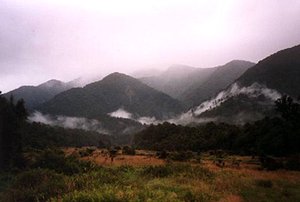 Cobland Valley, north of Haast, South Island. Source: Susanne Peck
Cobland Valley, north of Haast, South Island. Source: Susanne Peck This region's contiguous forest sequences, from [[mountain]s] to the coast, benefit birds like the vulnerable South Island kaka (Nestor meridionalis) that forage widely and migrate attitudinally looking for seasonal food sources. The [[coast]al margin] is also important as a breeding ground for many seabirds and penguins, like the Fiordland crested penguin (Eudyptes pachyrhynchus VU) which nests in Fiordland and Westland as far north as Okarito Lagoon.
Reptiles do not feature significantly in this ecoregion, probably for climatic reasons, and little is known about the area's forest invertebrates. However, the diversity (Species diversity) of alpine and subalpine invertebrates is high, with 60 percent of New Zealand's known species present, including half of New Zealand's 1500 moths. Eleven species of butterfly are present, including the rare black Mountain ringlette (Percnodaimon pluto) which is found above 1800 metres (m). The carnivorous Ross' land snail (Powelliphanta rossiana), which has several subspecies, was once found along the length of the South Island but is now confined to a few subalpine sites within the region.
Podocarps are the dominant canopy and emergent forest trees in Westland, with a variety of broadleaf species in the subcanopy and shrub layers. This region contains over half of New Zealand's remaining lowland podocarp/broadleaf forest, the majority of this in the south. In contrast beech species (Nothofagus spp.) are conspicuously absent between 42°E 50'S and 43°E 40'S. This 'beech gap' is thought to be a consequence of the ice ages when massive glaciers eradicated all vegetation. When suitable beech habitat was available again, it was occupied by conifer broadleaf species as their seeds are quickly dispersed by birds. With only limited dispersal ability, beech made few inroads into the new territory.
The region's swamps, lakes, and estuaries are the least modified in the country. Sixteen species of New Zealand's native freshwater fish have been recorded in the region including the threatened giant kokopu (Galaxias argenteus), short-jawed kokopu (G. postvectis), and the inanga (G. maculates) whose young are considered a culinary delicacy. Many wetland birds thrive here, including the Australsian bittern (Botaurus stellaris poiciloptilus) and the magnificent white heron or kotuku (Egretta intermedia). The Waitangiroto River is the only place where kotuku breed in New Zealand, although they are also present in Australia. About 55 pairs share their small breeding area with royal spoonbills (Platalea leucorodia regia) and spotted shags (Phalacrocorax punctatus). In the faster flowing mountain streams there are low numbers of the whio or blue duck (Hymenolaimus malacorhynchos VU), New Zealand's only torrent duck.
Current Status
A significant portion of the land in this region is protected. In south Westland 4700 square-kilometers (km2) of land is protected, including two-thirds of Mt Aspiring National Park. In the central part of the region 3479 km2 is protected, half of this in Westland National Park. This park and all the protected areas south of it are part of South West New Zealand Te Wahipounamu World Heritage Area. In the last 30 years, large areas have been brought into the protected area network. For example, in 1982 a large block of lowland forest was added to Westland National Park increasing its size by 40 percent, and in 1990 the Red Hills were brought into Mt Aspiring National Park. In general the conservation emphasis has shifted from the historical focus on alpine (non-productive) areas to lowland ecosystems which have been under-represented both nationally and locally for some time.
As well as the national parks there are a number of important reserves which were established to protect particular species or ecosystems. For example, the Waitangiroto Nature Reserve was established in 1957 to protect the kotuku nesting area and the 30 km2 Saltwater Ecological Area protects one of New Zealand's largest unmodified estuaries and the surrounding swamp forest. While some of the areas protecting lowland forest remnants are fragmented, in general the protected areas do provide excellent continuity and protect a variety of ecosystems.
However, while large areas of land are protected, this region is not totally pristine. As in other parts of mainland New Zealand, the wildlife, particularly the larger endemic and flightless birds, has been seriously affected by the introduction of predators like stoats (Mustela erminea) and rats (Rattus rattus and R. norvegicus). In addition, substantial portions of the fertile lowlands and hill country have been developed for pasture and plantations of pine (mainly Pinus radiata).
In 2000 the Government ordered that the State-owned enterprise 'Timberlands' stop logging native timber on West Coast lands by 31st March 2002. A review team that analyzed the conservation values of the affected land has suggested that the majority of the 1,300 km2 under consideration should be administered by the Department of Conservation.
Types and Severity of Threats
Maintaining the intact and unmodified nature of Westland's natural areas is a priority, along with the protection of a greater range of lowland ecosystems. One of the greatest difficulties on the coast is balancing the need for local communities to maintain their economic viability (in a remote area with limited opportunities for growth) with the need for conservation. Land clearance and development is a significant risk to natural ecosystems, especially those that are already fragmented or occur on unprotected land. Land clearance is normally associated with fragmentation, accelerated erosion, and the invasion of introduced weeds and pests.
In existing protected areas (including forested and subalpine regions), introduced predators, primarily rats, stoats, and possums (Trichosurus vulpecula), pose the greatest risks. The most vulnerable species are the small remnant populations of endemics like the Okarito kiwi, blue duck, and the Ross' land snail. Browsers are also a problem. The omnivorous possum causes widespread dieback of kamahi and southern rata while the regeneration of seedlings is impaired by red deer (Cervus elaphus) and chamois (Rupicapra rupicapra). Pest control within the region focuses on possums, deer, goats, and stoats.
Wetlands are also vulnerable. Modification of riparian margins and infestations of aquatic weed and pest fish species can have a profound effect. For example, the koi carp (Cyprinus carpio) is currently classified as 'noxious' under the freshwater Fisheries Regulations and 'unwanted' under the Biosecurity Act 1993. It is confined to the upper North Island, but has been moved to new areas in the past, so there is a risk it could be introduced into wetlands on the coast. These fish stir up sediments and spoil the habitat for native fish.
Justification of Ecoregion Delineation
The Westland temperate forests ecoregion is bordered by the ocean and the Southern Alps. There is good agreement between this ecoregion and Wardle's 'Westland' Botanical Province. Upland portions of this ecoregion are part of the 'South Island of New Zealand' Endemic Bird Area.
Further Reading
- For a terser summary of this entry, see the WWF WildWorld profile of this ecoregion.
- Dawson, J. 1988. Forest Vines to Snow Tussock: The Story of New Zealand's Plants. Victoria University Press. Wellington. ISBN: 0864730470
- Environment Waikato. 1999. Wetland Restoration. Wetland Factsheet Series: 1.
- Hilton-Taylor, C. 2000. The 2000 IUCN Red List of Threatened Species. IUCN, Gland, Switzerland and Cambridge, United Kingdom. ISBN: 2831705657
- Hutching, G. and C. Potton, editors. 1987. Forests, Fiords and Glaciers, New Zealand's World Heritage. Royal Forest and Bird Protection Society of New Zealand. Wellington. ISBN: 0959785108
- Kiwi Recovery website.
- McKinnon, M. Editor. 1997. New Zealand Historical Atlas, Ko Papatuanuku e Takoto Nei. David Bateman, Auckland. ISBN: 1869533356
- Molloy, L. 1988. Soils in the New Zealand Landscape: The Living Mantle. Mallinson Rendel. Wellington. ISBN: 0908606559
- Molloy, L. 1994. Wild New Zealand. New Holland Publishers. London. ISBN: 0262133040
- New Zealand Department of Conservation website.
- New Zealand Department of Conservation. 1996. West Coast conservation management strategy, 1996-2005: draft. West Coast Conservancy conservation management planning series, no. 2. West Coast Conservancy. Hokitika.
- New Zealand Department of Conservation. 2001a. Pest fish on the move. Information factsheet. Northern Regional Office, Hamilton.
- New Zealand Department of Conservation. 2001b. The Conservation requirements of New Zealand's nationally threatened invertebrates. Threatened species occasional publication: 20. Biodiversity Recovery Unit. Wellington.
- Soons, J. and M. Selby. Editors. 1982. Landforms of New Zealand. Longman Paul, Auckland. ISBN: 0582717868
- Stattersfield, A. J., M. J. Crosby, A. J. Long, and D. C. Wedge. 1998. Endemic Bird Areas of the World. Priorities for biodiversity conservation. BirdLife Conservation Series No. 7. BirdLife International, Cambridge, United Kingdom. ISBN: 1560985747
- Wardle, P. 1991. Vegetation of New Zealand. Cambridge University Press, Cambridge, United Kingdom. ISBN: 0521258731
- Yockney, I. J. and G. J. Hickling. 2000. Distribution and diet of chamois (Rupicapra rupicapra) in Westland forests, South Island, New Zealand. New Zealand Journal of Ecology, 24(1):31-38.
| Disclaimer: This article contains information that was originally published by the World Wildlife Fund. Topic editors and authors for the Encyclopedia of Earth have edited its content and added new information. The use of information from the World Wildlife Fund should not be construed as support for or endorsement by that organization for any new information added by EoE personnel, or for any editing of the original content. |
